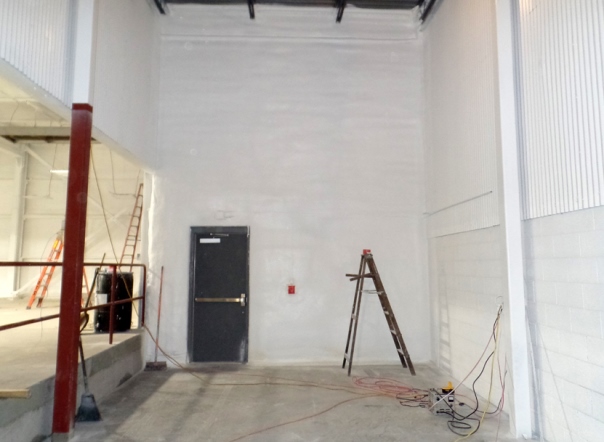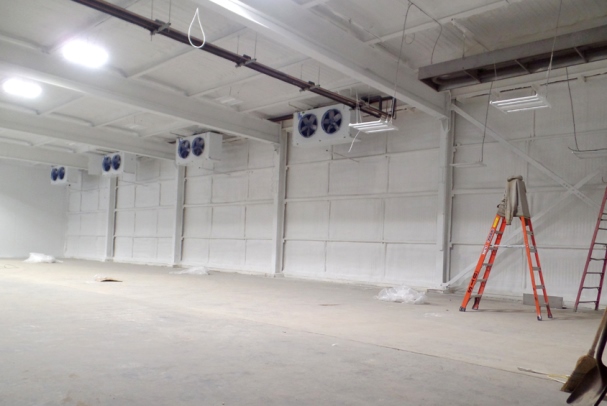A quote attributed to Mark Twain
—
“Why not go out on a limb? That’s where the fruit is.”
— may not have been written in relation to a coatings job, but it just might be relatable to United Thermal Solutions. Not only did the three-person United Thermal crew need to go out on a limb (aka man lift) to get this job done, but the project itself was for Sunset Fruit & Vegetable Company. For this duo, the fruit — both figuratively and literally — was indeed out on that limb.
Internal Sunshine
When Sunset Fruit, a Buffalo-based produce wholesaler, outgrew its facilities, they started looking for other buildings to move into. They found a good solution, but it needed rehab before they could move in. “When we first got there, there was rusted panels, dirt all over the walls, holes in the walls,” said United Thermal’s Vice President Larry Ash.
To fix the facility, the coatings crew needed to repair and clean the substrates and then install the coating system. Unfortunately, the 15-day project was completed during wintertime in upstate New York, which necessitated not only warm clothing and a warm break room for the crew, but also finding materials that could be applied below freezing temperatures and finding a way to keep them above freezing.
The crew used the trailer to keep both the materials and crew warm. “As a matter of fact, they had to keep them close to 75 degrees [23.9 °C],” Ash explained. On top of that, the coatings and spray polyurethane foam (SPF) were mainly applied from that man lift — not an easy task.
“It was a challenge. There’s no doubt about it,” Ash said. But the benefit of working in the winter is that it “kept [the] guys busy,” especially in Buffalo where the weather is “not too cooperative.”
And busy they were! Any panels that were too rusted needed to be replaced with galvanized steel to ensure a solid substrate — not a typical task for this crew.
“It was a learning experience,” Ash said. “We weren’t afraid to take a new challenge and do it. Our job is generally to spray polyurethane foam and coatings for roofing, or spray fireproofing, but when it comes to wall replacement, it was cheaper for us to do it for the owner rather than them hiring a separate subcontractor.”
Chilly Conditions
Once all rusted areas were replaced, the crew moved on to prep and paint. The crew cleaned all walls and ceilings with a Honda power washer using 4,000 psi (27.6 MPa) and a roto blaster tip. They wore waterproof clothing, respirators, and goggles during this phase, and they also wore safety harnesses and lanyards when working on the man lifts, regardless of the task.

Wielding a Graco 1095 airless sprayer, United Thermal applied Gaco Western’s two-part water-borne epoxy primer GacoFlex E5320 at approximately 3‒5 mils (76.2‒127.0 microns). It was sprayed onto all walls, beams, columns, and the ceiling.
Then, using safety signs from Spray Polyurethane Foam Association (SPFA) every 10 feet (3.1 m), the crew laid down the SPF, also called spray foam, next. They used a QuadFoam 2.0 Arctic Grade closed-cell spray foam, which according to the data sheet, can be applied in temperatures between 5 °F and 45 °F (-15.0‒7.2 °C).
“The biggest issue was that you couldn’t induce heat into the building because it would allow condensation to form on the walls, which would cause a bond/adhesion failure,” Ash explained. So the crew, powering through the cold, applied the foam in one pass to achieve a total average of 3 inches (7.6 cm). They wore fresh-air supplied hoods from Bullard, spray suits, and spray hats when applying the spray foam.
The Finished Look
“Our spray technician is the key to the whole project,” Ash said. “He sprays the foam, coatings, and intumescent as well as the paint. He is a master installer in the PCP [Professional Certification Program] at SPFA.” The end result mattered greatly on this project; the client wanted white, washable walls that would be visible.
“It had to not only perform but be aesthetically perfect,” Ash continued. “The other guys have experience spraying foam and coatings but he is the master guy who can make it look beautiful, so we depended on him to bring that aspect.”
The other two crew members had a great deal to focus on, too. “One guy is constantly going back checking the trailer, checking the pressure on the machines, making sure there’s sufficient hoses and material, prepping material before application. The second guy is dragging hoses and making sure the guy spraying the foam has proper materials and warnings of openings in the floor or things coming up upon that could be of danger,” Ash explained.
Keeping the crew safe was of utmost importance. They crew’s general safety gear included Honeywell half-face respirators and safety goggles and they used 48-inch (121.9 cm) fans for ventilation throughout the project.
Keeping the client safe after the project was done was another main goal. To do so, the crew spray applied an intumescent thermal barrier to meet NYS (New York State) Building Codes for exposed foam on the interior of the building. That was Flame Control’s 60-60A thermal barrier, which will provide a 15-min. thermal barrier over the spray foam if needed. That was installed at an average of 22 mils (558.8 microns) and then topped with Sherwin-Williams’ Metalatex at approximately 10 mils (254.0 microns). The Metalatex also topped any structural steel that received primer but no SPF or intumescent, creating a cohesive and protected building. “Once cured, it provided a washable surface to meet USDA [U.S. Department of Agriculture] requirements,” Ash explained.
Rising to the Challenge
For the United Thermal crew, this project ended up being anything but straight forward. “Our biggest challenge was when our trailer was broken into during the night,” Ash said. “They stole just about everything we had. They took safety glasses, harnesses, all the tools. They took all the good stuff.” And the coatings crew wasn’t the only one who got “hit.” “In other parts of the building, they took heaters, other trades’ tools; they were in and out pretty quick in the night,” he continued.
But without the time to stop and wait for the insurance to pay out, the crew purchased replacement items and kept on trudging forward.
“The owner is just thrilled with what we did,” Ash said. “We also did a spray foam roof for them at the same facility on the new addition because of the quality of work we did inside.” A happy client and more work: the fruits of their labor!
